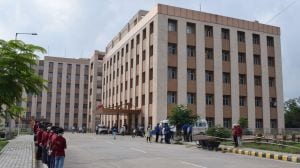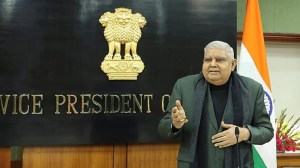The world’s highest rail bridge over Chenab likely to be ready this month
Once the 111-km stretch of the Udhampur-Srinagar-Baramulla Rail Link is completed, a train to Srinagar can reach all the way to Kanyakumari uninterrupted.
 The ‘Chenab Bridge’, hanging with its steel and concrete structure -- half-a-kilometre-long steel arch that defines it -- between Bakkal and Kauri, is 1,178 feet above the riverbed underneath, making it the world’s highest railway bridge. (Twitter/@RailMinIndia)
The ‘Chenab Bridge’, hanging with its steel and concrete structure -- half-a-kilometre-long steel arch that defines it -- between Bakkal and Kauri, is 1,178 feet above the riverbed underneath, making it the world’s highest railway bridge. (Twitter/@RailMinIndia) The world’s highest railway bridge on the Chenab river in Jammu and Kashmir is likely to be ready by the third week of this month.
The ‘Chenab Bridge’, hanging with its steel and concrete structure — half-a-kilometre-long steel arch that defines it — between Bakkal and Kauri, is 1,178 feet above the riverbed underneath, making it the world’s highest railway bridge.
Once the work is over, it will be a major milestone in reaching the completion of the Udhampur-Srinagar-Baramulla Rail Link (USBRL), also known as the Kashmir link. The bridge, being built at around Rs 1,400 crore, is the biggest civil-engineering challenge faced by any railway project in India in recent history.
Once the 111-km stretch is done, a train to Srinagar can reach all the way to Kanyakumari uninterrupted.
Over the past three years, engineers have been building the arch with the help of two mammoth cable cranes installed on both banks of the Chenab — the Kauri end and the Bakkal end.
The biggest challenge was that the 550-metre arch, weighing 10,000 metric tonnes, had to stand only with support from the two embankments and without any intermediate pier. Since the river flows 359 metres below the bridge no pier could possibly come at such a height. From “support to support”, the distance is 467 metres. The whole bridge will weigh around 29,000 metric tonnes. Engineers started work from embankments simultaneously, starting with installing the cranes that would launch the arch.
Each specially-designed cable crane is around a kilometre long. The two cranes have been working independently and also in synchrony, from each bank and joining pieces of the arch bit by bit.
A national accredited welding lab-cum-workshop was erected on the construction site to wield the steel pieces — a first for a project in India. Steel pieces are cut with computerised machines, and then they are tested as per the standard before being okayed for deployment. The total length of all the wielding done for the arch, if added together, is around 550 km, “almost the distance between Delhi and Jammu,” an official said.
Currently, the railway link to Kashmir is basically a 25-kilometer stretch of Udhampur to Katra, and 18 km of the line from Banihal to Qazigund in the valley and after that a 118 Qazigund-Baramulla stretch. These have been running for years.
The only missing link is the 111-km geologically treacherous stretch between Katra and Banihal. There is also a smaller bridge over the river Anji before the Chenab, but as far as engineering challenge is concerned, it is no match for the Chenab bridge, railways engineers say.












